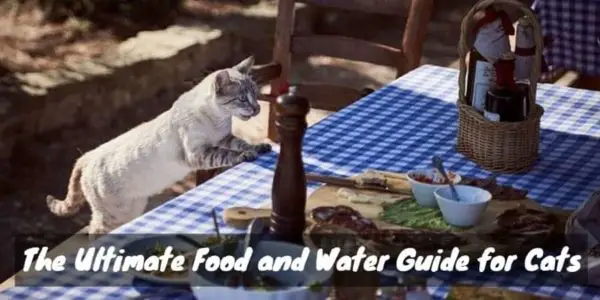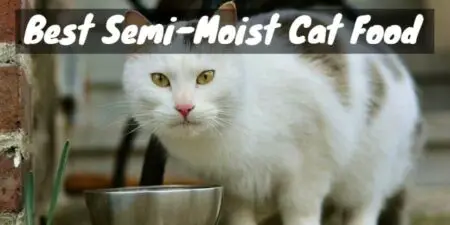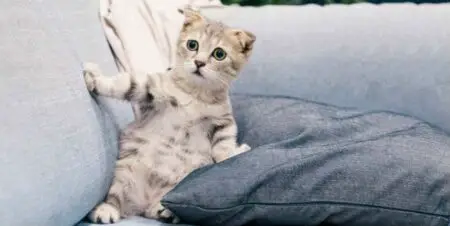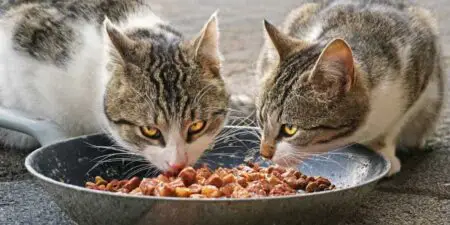If you want to keep your cat happy and healthy, it’s important to provide her with a nutritious diet and keep her hydrated. Just like for humans, diet can make a big difference in helping your feline companion stay in good shape for as long as possible. This guide will help you learn about some of the best practices when feeding your cat.
Cat Feeding Guidelines: Dry or Wet?
One of the first choices you will face is whether to give your cat wet food, or dry food (also known as kibble). While kibble can provide your cat with all the essential nutrients, many veterinarians recommend a wet diet. Wet food has a higher water content, a lower carbohydrate content, and more animal proteins, and it’s less processed and less likely to be contaminated.
Wet food is like the prey that cats catch and eat in the wild, while dry food contains grains and very little moisture. In the wild, cats don’t drink much water because they get the water content they need from their food, so they tend to have a low thirst drive and might not drink enough. Therefore, cats on a kibble diet are more likely to become chronically dehydrated, which can lead to kidney disease or lower urinary tract disease.
[amazon bestseller=”cat wet food” items=”1″ template=”table”]
Dry food can be left out for long periods of time, but this can lead to your cat becoming overweight or obese. Obesity in cats can lead to diabetes and other health problems. Dry food has been shown to be better at keeping cats’ teeth clean, but it has only a slight advantage in this regard.
What Is the Best Food for an Adult Cat?
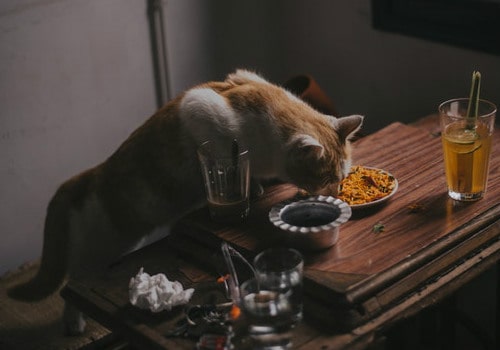
For proper nutrition, a cat’s diet should include the right balance of proteins, fats, minerals, vitamins, carbohydrates, and water. If your cat has more specific dietary needs, special cat foods are available for addressing a wide range of issues. Prescription diets are available for cats who are overweight, have digestive issues, or have kidney failure or other medical disorders.
What if Your Cat Is a Fussy Eater?
Many cats become very particular about what is in their food bowls. Some prefer certain flavors or textures, while others might get bored of the same food every day and yearn for variety. Fussy eating is a bad habit that cats develop, and there are things you can do to discourage this behavior.
For fussy cats, it is extra important to stick to a routine and to be patient. Don’t give in to them by offering treats. This gives them the message that they get rewarded for refusing to eat their regular meals.
To encourage a fussy cat to eat, try serving the meal in a different way. Be sure your cat has a quiet place to eat where she won’t be disturbed. If that doesn’t work, try a different bowl or consider changing to a different food.
You should consult your veterinarian if your cat still won’t eat or goes 24 hours or more without eating. Your cat might have dental problems or sore gums that make eating painful. Or your cat might have an obstruction or illness that is affecting her appetite or ability to eat.
Other Food Tips
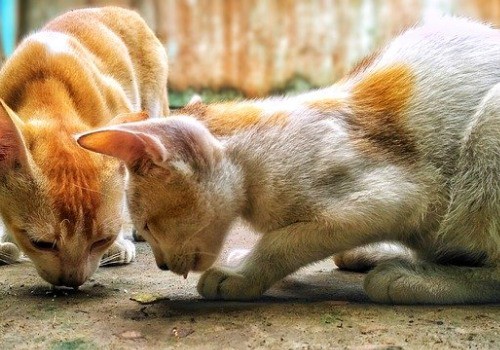
Consider feeding your cats on a schedule that mimics the way they would eat if they were out on their own. To accomplish this, you would feed one meal in the morning at dawn and a second meal at dusk. While free feeding is convenient, meal-time feeding on a set schedule will give more control over what and how much your cat eats.
Feeding your cat according to a schedule, at the same times and place each day, will train your cat to know when to expect her meals and make him/her less likely to demand food throughout the day. Place the food in a quiet but accessible area on a clean surface away from litter pans. If you have more than one cat, providing each one with a separate food and water bowl will keep them from fighting over food.
[amazon bestseller=”cat food” items=”1″ template=”table”]
The amount of food needed for a cat depends on size, age, and level of activity. As a rule of thumb, A typical adult cat eats about 5.5 ounces of wet food and about two ounces of dry food per day or 24-35 calories per day per pound of body weight. A kitten needs approximately twice as much food per day as an adult cat.
Provide a rotating diet for your cats. If you feed your cats the same food every day for long periods of time, they are more likely to develop allergies and sensitivities. Try changing your cat’s diet two or more times per year, but if your cat won’t eat new foods or is resistant, try a more gradual approach.
When changing to a new food, begin by mixing the new food with the old food. Each day cut the amount of the old food and increase the amount of the new food. A gradual transition over seven to ten days will help your cat adjust to a new diet with less chance of stomach upset.
Water Tips
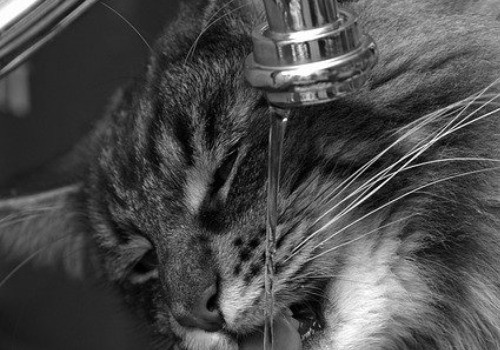
Cats’ bodies are comprised of 60-70% water, and they need water to live a healthy life. Hydration is critical to maintaining the proper balance of electrolytes, which affects circulation and digestion. Fresh water helps to keep your cat’s kidneys healthy and reduces the chance of developing urinary tract infections.
In order to stay hydrated, cats need fresh water available every day all year round. In the summertime, cats need to drink more water, and cats that eat dry food need more water than cats that eat wet food. This is because dry cat food only contains 10% water, while wet cat food contains 78% water.
Generally speaking, cats need 3.5 to 4.5 ounces of water per five pounds of body weight per day, although cats eating canned food will get more of this from their food. When cats drink more water than usual, it might indicate a medical condition such as diabetes or kidney disease, so a veterinarian should check them out.
Some cats prefer running water and will drink more from a cat fountain. Others don’t like the taste of chlorine and prefer bottled water. Adding catnip to the water bowl might entice your cats to drink more water.
[amazon bestseller=”cat water fontain” items=”1″ template=”table”]
If your cat refuses to drink and becomes dehydrated, you can try using a syringe to provide either water or an electrolyte solution. Dispense the fluid slowly so your cat is able to swallow it without choking.
Other options for treating dehydration in cats include administering fluid subcutaneously, under the skin, or through an IV. Your veterinarian can administer fluids and teach you the proper way to administer subcutaneous fluids at home.
Should Cats Drink Milk?

Although many people believe cats love milk, giving milk to an adult cat is not good. It’s not beneficial to them and might cause stomach upset. Cats are lactose intolerant and have a hard time digesting milk.
Kittens drink their mother’s milk until they are weaned, but after that, they should be given water and soft kitten food to drink and eat. There are kitten formulas available for a small kitten who has lost its mother. Lactose-free cat milk can be given as a treat, but it’s not a necessary part of a cat’s diet.
Food and Water Bowls Make a Difference
It isn’t just what you put in the bowl, but the bowl itself that can make a difference when it comes to keeping your cats properly nourished and hydrated. Plastic bowls are convenient, but some cats are allergic to plastic. Also, they can crack, causing leaks or contamination. Therefore, stainless steel or ceramic bowls are the best choices for both food and water bowls.
Select a bowl that is large enough for your cat to enjoy a meal without it touching her whiskers, and that won’t tip over or slide around easily. A placemat under the bowls will help protect your floor from spills and keep the eating area clean and neat. If you work late or need to be away from home, you might consider an automatic feeder, which can be programmed to dispense food at intervals throughout the day.
What Are Some Common Mistakes People Make?
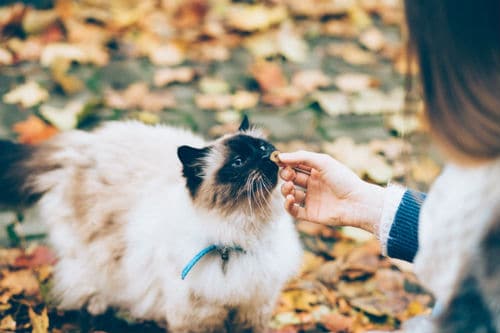
Overfeeding is the most common mistake that cat owners make. Most indoor cats are not very active and don’t get much exercise, which means they don’t need as much food. Feeding only kibble is another common mistake because it can lead to dehydration.
Feeding your cat human foods is also a common mistake that should be avoided. Table scraps don’t provide the nutrients cats need and might upset their stomachs. Worse than that, some common human foods, like onions, garlic, chocolate, and mushrooms, are actually toxic for cats.
Manufactured cat treats are a better option if you want to give your cat a treat. Most cats love them, and they shouldn’t upset your cat’s stomach or nutritional balance. Just be sure not to overdo the treats and to adjust your cat’s calorie intake accordingly.
Other mistakes include trying to feed cats a vegetarian or vegan diet, or preparing homemade food that does not meet a cat’s nutritional needs. Cats are obligate carnivores and need meat and the proper balance of certain minerals in order to survive.
[amazon bestseller=”cat bowls” items=”1″ template=”table”]
Final Thoughts
Ultimately, the right type and amount of food and water for your cat depend on a number of factors. When determining what and when to feed your cat, you should take into account weight and age, whether you will feed wet food, kibble, or a combination of the two, and your cat’s activity level. If you are careful about what you feed your cat and stick to a set feeding schedule, your cat is less likely to become overweight or obese and more likely to live a long and healthy life.
How to Make Raw Cat Food — a Recipe (Video)
10 Related Questions About Food and Water for Cats
1. How can you determine if your cat is getting the right amount of nutrients in their diet?
Monitor your cat’s weight, energy levels, and overall health. Consult your veterinarian to ensure the chosen food meets their nutritional needs and adjust the diet as needed.
2. What are the signs of dehydration in cats, and how can you prevent it?
Signs of dehydration include lethargy, sunken eyes, and skin tenting. Prevent dehydration by providing fresh water daily, feeding wet food, and encouraging water consumption through cat fountains or adding water to their food.
3. How do you introduce new food to a cat with food allergies or sensitivities?
Introduce the new food gradually by mixing it with their current food over a 7-10 day period. Consult your veterinarian for food recommendations tailored to your cat’s specific allergies or sensitivities.
4. What factors should be considered when choosing a cat food brand?
Consider factors such as ingredient quality, nutritional content, and the brand’s reputation. Look for foods that meet AAFCO guidelines and consult your veterinarian for recommendations.
5. How can you encourage a cat to drink more water if they are not attracted to water bowls or fountains?
Try offering flavored water with a small amount of tuna juice or chicken broth, changing the water source location, or using different types of bowls like ceramic or stainless steel.
6. Are there any human foods that can safely be given to cats as treats?
Some safe human foods for cats include plain, cooked meats like chicken, turkey, or beef, and small amounts of cooked vegetables or eggs. Always avoid toxic foods like onions, garlic, and chocolate.
7. What is the best way to transition a cat from a kibble diet to a wet food diet?
Transition gradually by mixing wet food with kibble over a 7-10 day period, slowly increasing the proportion of wet food while decreasing the kibble until the cat is fully adapted to the wet food.
8. How do you manage to feed multiple cats with different dietary needs in the same household?
Feed cats separately in different rooms or at different times, and monitor their eating habits to ensure they’re consuming their own food. Use puzzle feeders or slow feeders to control portions and prevent overeating.
9. How can you address dental health in cats on a wet food diet?
Promote dental health with dental chews or treats, regular brushing of your cat’s teeth, and scheduling professional dental cleanings with your veterinarian as needed.
10. How do you know if your cat’s food bowl is the right size and shape for his/her comfort?
Choose a bowl that allows your cat to eat without their whiskers touching the sides, and ensure it has a stable base to prevent tipping or sliding. Observe your cat’s eating habits and adjust the bowl size or shape as needed.
"In ancient times cats were worshipped as gods; they have not forgotten this."
-- Terry Pratchett

